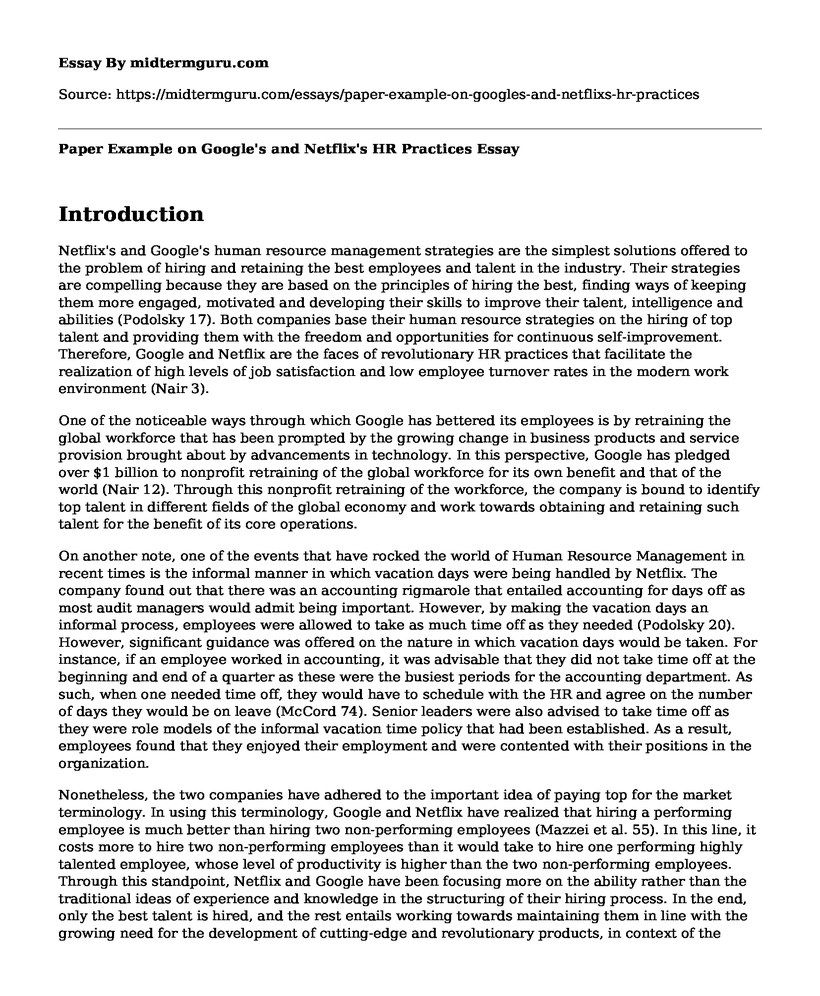Introduction
Netflix's and Google's human resource management strategies are the simplest solutions offered to the problem of hiring and retaining the best employees and talent in the industry. Their strategies are compelling because they are based on the principles of hiring the best, finding ways of keeping them more engaged, motivated and developing their skills to improve their talent, intelligence and abilities (Podolsky 17). Both companies base their human resource strategies on the hiring of top talent and providing them with the freedom and opportunities for continuous self-improvement. Therefore, Google and Netflix are the faces of revolutionary HR practices that facilitate the realization of high levels of job satisfaction and low employee turnover rates in the modern work environment (Nair 3).
One of the noticeable ways through which Google has bettered its employees is by retraining the global workforce that has been prompted by the growing change in business products and service provision brought about by advancements in technology. In this perspective, Google has pledged over $1 billion to nonprofit retraining of the global workforce for its own benefit and that of the world (Nair 12). Through this nonprofit retraining of the workforce, the company is bound to identify top talent in different fields of the global economy and work towards obtaining and retaining such talent for the benefit of its core operations.
On another note, one of the events that have rocked the world of Human Resource Management in recent times is the informal manner in which vacation days were being handled by Netflix. The company found out that there was an accounting rigmarole that entailed accounting for days off as most audit managers would admit being important. However, by making the vacation days an informal process, employees were allowed to take as much time off as they needed (Podolsky 20). However, significant guidance was offered on the nature in which vacation days would be taken. For instance, if an employee worked in accounting, it was advisable that they did not take time off at the beginning and end of a quarter as these were the busiest periods for the accounting department. As such, when one needed time off, they would have to schedule with the HR and agree on the number of days they would be on leave (McCord 74). Senior leaders were also advised to take time off as they were role models of the informal vacation time policy that had been established. As a result, employees found that they enjoyed their employment and were contented with their positions in the organization.
Nonetheless, the two companies have adhered to the important idea of paying top for the market terminology. In using this terminology, Google and Netflix have realized that hiring a performing employee is much better than hiring two non-performing employees (Mazzei et al. 55). In this line, it costs more to hire two non-performing employees than it would take to hire one performing highly talented employee, whose level of productivity is higher than the two non-performing employees. Through this standpoint, Netflix and Google have been focusing more on the ability rather than the traditional ideas of experience and knowledge in the structuring of their hiring process. In the end, only the best talent is hired, and the rest entails working towards maintaining them in line with the growing need for the development of cutting-edge and revolutionary products, in context of the technology industry (Mazzei et al. 57).
Conclusion
To sum it up, the above exploration reveals Human Resource practices that Google and Netflix have adopted to keep up with the changing business environment and advancements in technology. Google implements a retraining program for its workforce whilst Netflix has an informal vacation time policy that allows employees to take as much time off as they need. All in all, Google and Netflix conform to the idea of paying top of the market by ensuring that they hire performing employees, regardless of their number, as opposed to many non-performing employees. The outcome of the changed practices is well evident as the companies are now able to hire top talent and retain more employees than ever before.
Works Cited
Mazzei, Matthew J., C. Brian Flynn, and Jeffrey J. Haynie. "Moving beyond initial success: Promoting innovation in small businesses through high-performance work practices." Business Horizons 59.1 (2016): 51-60.
McCord, Patty. "How Netflix reinvented HR." Harvard Business Review 92.1 (2014): 70-76.
Nair, Manju. "Current Status of Analytics in HR: Evidence-Based Review." SCMS Journal of Indian Management 15.2 (2018).
Podolsky, Mark. "The process of strategic work modelling: Drawing clear connections between organizational strategy and human resource management practices." Organizational Dynamics 47.1 (2018): 17-24.
Cite this page
Paper Example on Google's and Netflix's HR Practices. (2022, Oct 20). Retrieved from https://midtermguru.com/essays/paper-example-on-googles-and-netflixs-hr-practices
If you are the original author of this essay and no longer wish to have it published on the midtermguru.com website, please click below to request its removal:
- Preparing CV for Placement Managers to Read and Ask Questions About Me in an Interview
- Essay on Cece Winans as an Activist Through her Music and Career
- Vis Cement Company - Reflective Essay
- Assignment Example on Professional Development
- Essay Sample on Career Development
- Fresh College Grads: Get Real-World Experience With a Job Training Program - Essay Sample
- Ready for Career? Preparing Students for 21st Century Challenges - Essay Sample







